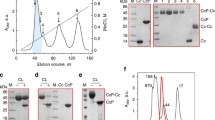Abstract
A previously developed theory of particulate electron conduction enzymes was based on a model of an enzyme particle catalyzing the oxidation-reduction of two different substrates at two different enzymatic sites on the same particle with conduction of electrons between the two sites through the enzyme particle. Using the simplifying assumption that the percent reduction of the second substrate is held constant, there was previously shown to be a hyperbolic relationship between the first order rate constant (k′) and the sum (C x ) of oxidized plus reduced substrate, of the formk′=α/(C x +β), where α and β are positive constants. It is shown here that if this simplifying assumption is omitted, a positive constant is added to the right hand side of this equation, which describes exactly the experimental data of Smith and conrad on cytochrome oxidase. If electron transport is assumed to be coupled to ion transport, this equation becomesk′=(α/C x )−γ (where γ is a positive constant) which describes the experimental data of Eadie and Gale on pyruvic carboxylase of yeast. It seems probable that the same theory is applicable to coupled ion-ion transport and coupled electron-electron transport in both membranous systems, and in particulate preparations consisting of membrane fragments.
Similar content being viewed by others
Literature
Beetlestone, J. 1960. “The Oxidation of CytochromeC by CytochromeC Peroxidase.”Arch. Biochem. Biophys.,89, 35–40.
Brattain, W. H., and C. G. B. Garrett. 1954. “Surface Properties of Germanium and Silicon.”Ann. N. Y. Acad. Sci.,58, 951–958
Cope, F. W. 1963a. “A Kinetic Theory of Enzymatic Oxidation-Reduction Reactions Based on a Postulate of Electron Conduction in a Macromolecular Enzyme with an Application to Active Transport of Small Ions across Biological Membranes.”Bull. Math. Biophys.,25, 165–176.
Cope, F. W. 1963b. “A Theory of Enzyme Kinetics Based on Electron Conduction through the Enzymatic Particles, with Application to Cytochrome Oxidases and to Free Radical Decay in Melanin.”Arch. Biochem. Biophys.,103, 352–365.
Cope, F. W. 1964a. “Eye Melanin Free Radical Kinetics and Mechanism in Relation to the Roginsky-Zeldovich (or Elovich) Equation and the Adsorption of Oxygen by Semiconductors.”J. Chem. Phys., in press.
Cope, F. W. 1964b. “A Theory of Ion Transport across Cell Surfaces by a Process Analogous to Electron Transport across Liquid-Solid Interfaces.”Bull. Math. Biophys., in press.
Cope, F. W. 1964c. “Elovich Decay of Free Radicals in a Photosynthetic System as Evidence for Electron Transport across an Interfacial Activation Energy Barrier.”Proc. Nat. Acad. Sci. (U.S.A.), in press.
Denbigh, K. G. 1951.The Thermodynamics of the Steady State. N.Y.: Wiley.
Eadie, G. S., and G. R. Gale. 1961. “Studies of Enzyme Kinetics. I. The Course of the Reaction and the Effect of a Second Addition of Substrate on Pyruvate Carboxylase of Yeast.”Arch. Biochem. Biophys.,93, 37–42.
Fuller, C. S. 1958. “Some Analogies between Semiconductors and Electrolyte Solutions.”Record of Chem. Progress,17, 75–93.
Green, D. E., D. Herbert, and V. Subrahmanyan. 1941. “Carboxylase.”J. Biol. Chem.,138, 327–339.
Green, M. 1959. “Electrochemistry of the Semiconductor-Electrolyte Interface.”Modern Aspects of Electrochemistry,2, J. O. Bockris, Ed. London: Butterworths.
Jahn, T. L. 1962. “A Theory of Electronic Conduction through Membranes, and of Active Transport of Ions, based on Redox Transmembrane Potentials.”J. Theoret. Biol.,2, 139–138.
Ling, G. 1962.A Physical Theory of the Living State. New York: Blaisdell.
Ling, G. N. 1964. Unpublished experiments.
Minnaert, K. 1961. “The Kinetics of CytochromeC oxidase.”Biochem. et. Biophys. Acta,50, 23–34.
Mauro, A., and A. Finkelstein. 1963. “Principles of Ionic Physics Related to Physiological Membranes and Solid State Devices.”Proceeding of the 16th Annual Conference on Engineering in Medicine and Biology. Baltimore, Maryland.
Onsager, L. 1931a. “Reciprocal Relations in Irreversible Processes. I.,”Phys. Rev.,37, 405–426.
Onsager, L. 1931b. “Reciprocal Relations in Irreversible Processes. II.”Phys. Rev.,38, 2265–79.
Prigogine, L. 1961.Introduction to Thermodynamic of Irreversible Processes. Second edition. New York: Wiley.
Singer, T. B., and J. Pensky. 1952. “Isolation and Properties of the α-Carboxylase of Wheat Germ.”J. Biol. Chem.,196, 375–388.
Smith, L., and H. Conrad. 1956. “A Study of the Kinetics of the Oxidation of CytochromeC by CytochromeC Oxidase.”Arch. Biochem. Biophys.,63, 403–413.
Author information
Authors and Affiliations
Rights and permissions
About this article
Cite this article
Cope, F.W. A generalized theory of particulate electron conduction enzymes applied to cytochrome oxidase. A theory of coupled electron and/or ion transport applied to pyruvate carboxylase. Bulletin of Mathematical Biophysics 27, 237–252 (1965). https://doi.org/10.1007/BF02478401
Received:
Issue Date:
DOI: https://doi.org/10.1007/BF02478401




